AAO-NANOS Neuro-Ophthalmology Clinical Collection: Derived from the AAO-NANOS Clinical Neuro-Ophthalmology collection produced on CD. The images are of selected cases from the NANOS teaching slide exchange, and the CD was produced under the direction of Larry Frohman, MD and Andrew Lee, MD.
The American Academy of Ophthalmology (AAO); The North American Neuro-Ophthalmology Association (NANOS).
NOVEL: https://novel.utah.edu/
TO
Filters: Collection: ehsl_novel_aao_nanos
| Title | Description | Subject | ||
|---|---|---|---|---|
| 201 |
 |
Motility Disturbances | This man had a posttraumatic right sixth nerve paresis. He is shown in primary gaze after Botox (image 94_65). | Trochlear Palsy |
| 202 |
 |
Motility Disturbances | This man had a posttraumatic right sixth nerve paresis. Image 94_66 demonstrates the adduction deficit that the Botox induced. | Trochlear Palsy |
| 203 |
 |
Motility Disturbances | This young woman had bilateral sixth nerve paresis from a motor vehicle accident. The images show the results of a successful Jensen procedure. | Abducens Palsy |
| 204 |
 |
Motility Disturbances | This young woman had bilateral sixth nerve paresis from a motor vehicle accident. The images show the results of a successful Jensen procedure. | Abducens Palsy |
| 205 |
 |
Motility Disturbances | This patient sustained a traumatic avulsion of the left medial rectus. | Avulsion of Medial Rectus |
| 206 |
 |
Motility Disturbances | This patient sustained a traumatic avulsion of the left medial rectus. | Avulsion of Medial Rectus |
| 207 |
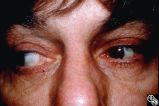 |
Motility Disturbances | This patient sustained a traumatic avulsion of the left medial rectus. Image 94_75 shows the successful postoperative result. | Avulsion of Medial Rectus |
| 208 |
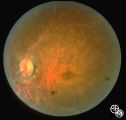 |
Systemic Disorders With Optic Nerve and Retinal Findings | This 57-year-old man had a neuro-ophthalmology consult, requested the night before his 2-cm pituitary tumor was to be resected. His examination revealed his acuities to be 20/70 OU, with a visual field not consistent with chiasmal compression. The fundus appearance, with peripheral salt and pepperin... | Syphilis |
| 209 |
 |
Systemic Disorders With Optic Nerve and Retinal Findings | This 8-year-old girl had a history of acute lymphoblastic leukemia with neurologic involvement, with remission induced with radiation and chemotherapy. Her relapse showed as an isolated optic neuropathy with this fundus appearance. The other eye was normal. The MRI and spinal tap at this point were ... | Leukemia, Radiation; Chemotheraphy; Retianl Complications |
| 210 |
 |
Neuro-Ophthalmic Consequences of Therapy | This woman presented at age 52, 3 years after radiation therapy for a salivary gland carcinoma extending into the right maxillary sinus. She had received 6000 rads in 30 fractions over 45 days. She presented with 3 weeks of visual loss, with acuity of 20/30, normal color plates, normal fields, and n... | Radiation Retinopathy |
| 211 |
 |
Neuro-Ophthalmic Consequences of Therapy | This woman presented at age 52, 3 years after radiation therapy for a salivary gland carcinoma extending into the right maxillary sinus. She had received 6000 rads in 30 fractions over 45 days. She presented with 3 weeks of visual loss, with acuity of 20/30, normal color plates, normal fields, and n... | Radiation Retinopathy |
| 212 |
 |
Neuro-Ophthalmic Consequences of Therapy | This woman presented at age 52, 3 years after radiation therapy for a salivary gland carcinoma extending into the right maxillary sinus. She had received 6000 rads in 30 fractions over 45 days. She presented with 3 weeks of visual loss, with acuity of 20/30, normal color plates, normal fields, and n... | Radiation Retinopathy |
| 213 |
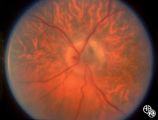 |
Congenitally Tilted Optic Disc | Colobomas or defects of the optic nerve may exhibit spontaneous pulsations. Disease/Diagnosis: Coloboma. | Coloboma |
| 214 |
 |
Isolated Optic Neuritis/Neuropathy | This image demonstrates Paton's lines in a 34-year-old patient with pseudotumor cerebri and chronic papilledema. | Pseudotumor Cerebri/Papilledema; Edema |
| 215 |
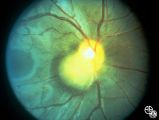 |
Ocular Manifestations of Congenital/Inherited Diseases | Note the retinal/optic nerve head astrocytoma in a 12-year-old boy with tuberous sclerosis. Disease/Diagnosis: Tuberous Sclerosis. | Tuberous Sclerosis |
| 216 |
 |
Isolated Optic Neuritis/Neuropathy | This 35-year-old otherwise-healthy woman developed typical optic neuritis OD with excellent recovery. She had no clinical evidence of multiple sclerosis at that time. She presented in August of 1991, at which time perivenous sheathing was seen in the retinal periphery OU. A limited workup was negati... | Periphlebitis in Optic Neuritis |
| 217 |
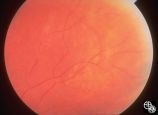 |
Isolated Optic Neuritis/Neuropathy | This 35-year-old otherwise-healthy woman developed typical optic neuritis OD with excellent recovery. She had no clinical evidence of multiple sclerosis at that time. She presented in August of 1991, at which time perivenous sheathing was seen in the retinal periphery OU. A limited workup was negati... | Periphlebitis in Optic Neuritis |
| 218 |
 |
Isolated Optic Neuritis/Neuropathy | This 35-year-old otherwise-healthy woman developed typical optic neuritis OD with excellent recovery. She had no clinical evidence of multiple sclerosis at that time. She presented in August of 1991, at which time perivenous sheathing was seen in the retinal periphery OU. A limited workup was negati... | Periphlebitis in Optic Neuritis |
| 219 |
 |
Isolated Optic Neuritis/Neuropathy | This 35-year-old otherwise-healthy woman developed typical optic neuritis OD with excellent recovery. She had no clinical evidence of multiple sclerosis at that time. She presented in August of 1991, at which time perivenous sheathing was seen in the retinal periphery OU. A limited workup was negati... | Periphlebitis in Optic Neuritis |
| 220 |
 |
Isolated Hereditary Optic Neuritis/Neuropathy | Leber's hereditary optic neuropathy is a mitochondrial hereditary optic neuropathy that usually affects young males but may occur at any age and in males or females. The clinical features are usually acute bilateral simultaneous or sequential visual loss with a central acuity and central visual fiel... | Leber's Optic Neuropathy |
| 221 |
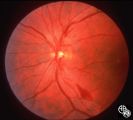 |
Isolated Hereditary Optic Neuritis/Neuropathy | Leber's hereditary optic neuropathy is a mitochondrial hereditary optic neuropathy that usually affects young males but may occur at any age and in males or females. The clinical features are usually acute bilateral simultaneous or sequential visual loss with a central acuity and central visual fiel... | Leber's Optic Neuropathy |
| 222 |
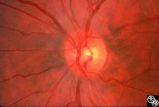 |
Isolated Hereditary Optic Neuritis/Neuropathy | Leber's hereditary optic neuropathy is a mitochondrial hereditary optic neuropathy that usually affects young males but may occur at any age and in males or females. The clinical features are usually acute bilateral simultaneous or sequential visual loss with a central acuity and central visual fiel... | Leber's Optic Neuropathy |
| 223 |
 |
Pupillary Syndrome | Intermittent dilation of the pupils may occur as a benign phenomenon in healthy young adults. In the absence of other third nerve signs, (eg, ptosis, diplopia, ophthalmoplegia), an isolated transient dilation of the pupil in an otherwise healthy adult is unlikely to represent a third nerve palsy. Tr... | Tadpole Pupils |
| 224 |
 |
Pupillary Syndrome | Intermittent dilation of the pupils may occur as a benign phenomenon in healthy young adults. In the absence of other third nerve signs, (eg, ptosis, diplopia, ophthalmoplegia), an isolated transient dilation of the pupil in an otherwise healthy adult is unlikely to represent a third nerve palsy. Tr... | Tadpole Pupils |
| 225 |
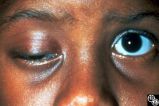 |
Motility Disturbances | Cyclical oculomotor paresis may occur in patients as an intermittent phenomenon, with a paretic phase and diplopia and intervals that are nonparetic. The history and examination are classic for the disorder. Pair with Images 95_19 and 95_20. | Oculomotor Palsy (Cyclical Oculomotor Palsy); Cyclical |
